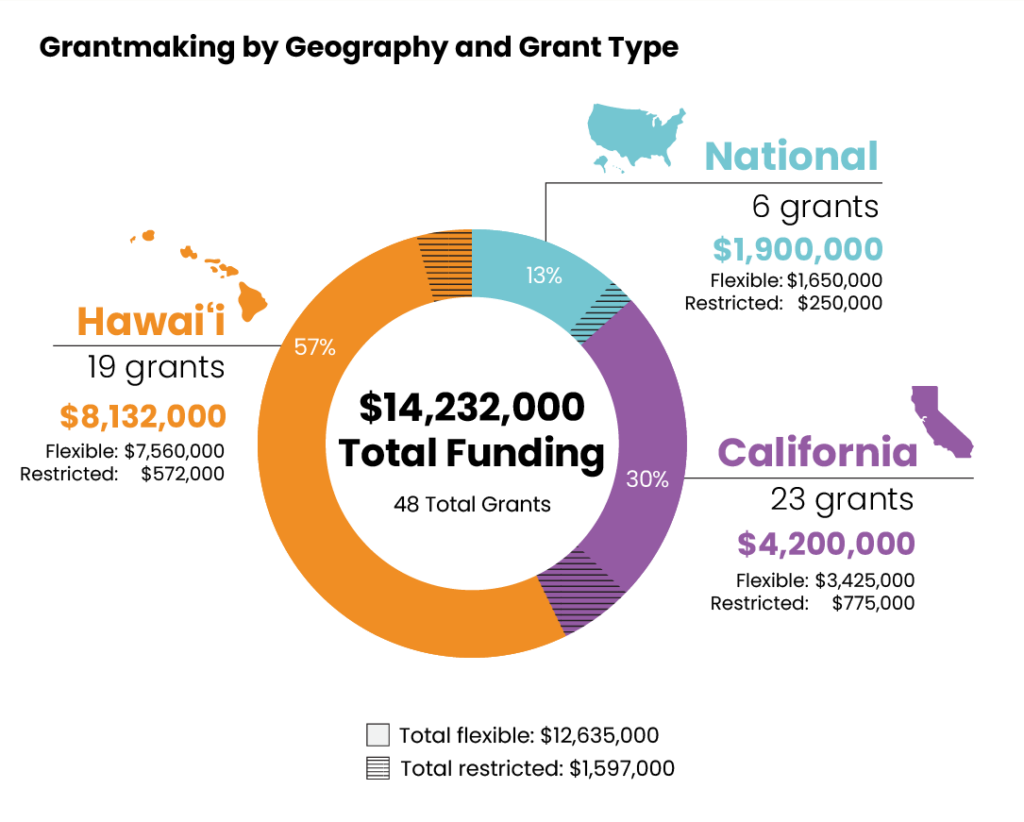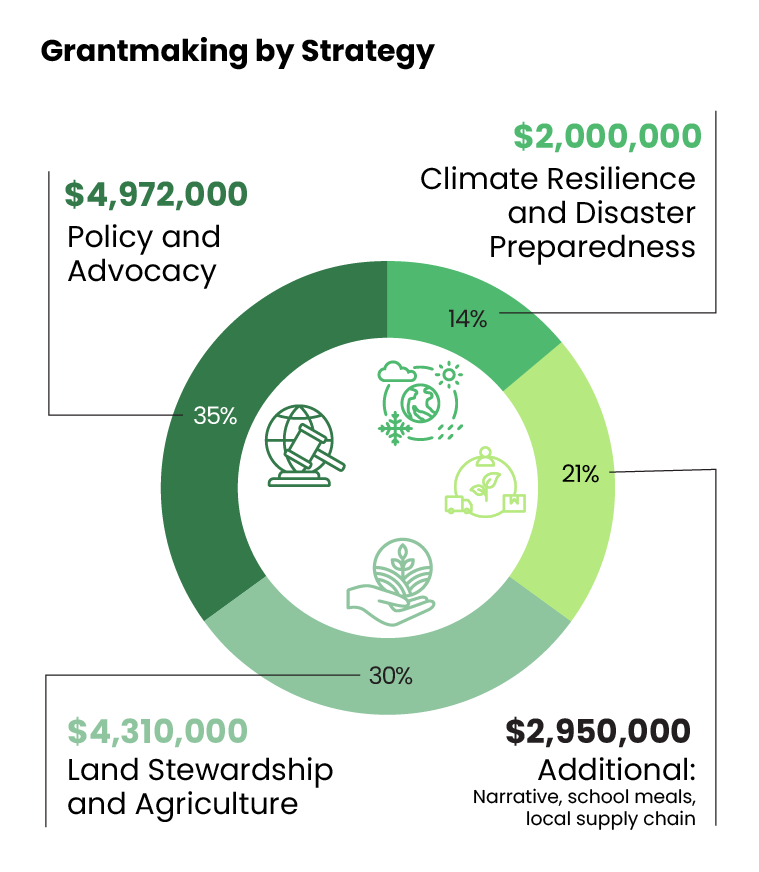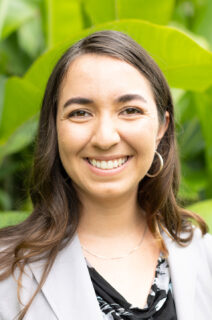April 25, 2025
In 2024, we returned $14 million to our grantee partners, the largest investment in our food justice partners to date.
Food can be a powerful catalyst for healing, equity, and community self-determination. As our team compiled this 2024 report, we reflected on the brilliance of our grantee partners who work to transform our food and agricultural systems every single day.
In 2024, communities faced the headwinds of climate disasters, recovery efforts, and pivotal federal and state elections. Against these odds, our grantee partners—land stewards, farmers, advocates, educators, movement builders, and cultural practitioners—continued to uplift a vision for change. They created mutual aid networks in the aftermath of disasters, cultivated new generations of advocates, resisted corporate polluters, restored healing cultural practices, and nurtured local economies. Our grantee partners continue to lead change both by countering harms and growing solutions that sustain communities. It is a joy and honor to witness their collective strength.
We also recognize the gravity of this moment. Recent federal actions and rhetoric are targeting communities, seeking to undermine the gains of diversity, equity, and inclusion, and sowing chaos through sweeping executive orders and policy change. Among the people most impacted by these orders are immigrant communities, farmers, and essential workers whose labor upholds the nation. We all deserve to live in a society that respects the full humanity, dignity, and potential of its people. The coming months and years will bring continued challenges and a shifting terrain. Our grantee partners remind us of what remains true: We each have a critical role to play in shaping change in our communities.
Food Justice Grantmaking in 2024
Total food justice funding
Grants
Return Dollars to Communities
Our understanding of food justice centers solutions that are place-based and collaborative and that reflect local communities’ wisdom. We prioritized funding progressive organizations that reflect the priorities and wisdom of historically marginalized and underrecognized communities, with people of color and women in leadership roles.
In 2024, we returned $14 million to our grantee partners. This marks the largest investment in our food justice partners before we issue final grants in this program in 2027 and ultimately close the foundation in 2029. Learn more about our spend down timeline.
Last year, the Food Justice program returned the majority of funds—$8,132,000—to Hawai‘i in recognition of historic disinvestment and current opportunities for transformation.

Whenever possible, we utilize flexible grantmaking practices so organizations can determine how to use funds to support their vision. Flexible grants (89%) include general operating or unrestricted support, which bolster an organization’s overall mission and sustainability beyond a single project. We deployed restricted grants (11%) when required by the opportunity or the organizational structure.
Since 2022, the Food Justice program has shifted a portion of the grantmaking decisions to existing community-advised funds and intermediaries. In 2024, communities stewarded $1.3 million of these funds.
Photo courtesy of Food and Agriculture Action Coalition Toward Sovereignty

Land Stewardship and Agriculture
Care for Healthy Lands and Healthy People
Just and thriving food systems are essential for just and thriving communities. We invested $4.31 million into an ecosystem of community organizations, farmers, land stewards, and coalitions working to change systems for good and build community power. This includes initiatives to protect land and return permanent assets to community control. As a new practice in 2024, for the first time, we awarded a grant directly to a for-profit agricultural cooperative, supporting efforts to connect communities with climate-resilient, culturally significant crops.
Total funding
Climate Resilience and Disaster Preparedness
Fund a Climate Resilient Future
In 2024, fires devastated communities across California, and Hawai‘i continued to recover and rebuild from the 2023 Lāhainā, Maui fires. We supported initiatives that focus on wellness through prevention, adaptation, and community-centered solutions to address and mitigate climate change-fueled impacts. Indigenous-led and community land stewardship initiatives, community-centered disaster planning, and long-term recovery exemplify this.
Total funding
Policy and Advocacy
Ensure Community Priorities Shape Policy
Grassroots movements have a critical role in amplifying community priorities and shifting systems before, during, and after a significant election year. We continued to support initiatives that elevate youth, intergenerational, and grassroots advocacy and organizing through 501(c)(3) funding. Along the way, we underwent organizational learning about 501(c)(4) funding as a tool to support greater impact. There is a misconception that private foundations cannot support 501(c)(4) organizations due to lobbying restrictions. With training from Northern California Grantmakers 501(c)(4) Power Building Cohort, we issued Stupski’s first grant to a (c)(4) in support of national efforts to protect democracy.
Total funding
Go Beyond the Grant
As funders, it’s a privilege to be able to move resources. We must also consider additional ways to support partners beyond the grant. We share this 2024 snapshot in the spirit of growing a culture of accountability within philanthropy and to offer greater transparency into our Food Justice program.
In 2024, we leaned further into our goals of “beyond the grant” support. This includes opportunities to connect grantees with training and capacity-building. Informed by a survey of grantee partner priorities, 80 organizations engaged in an online series offering a virtual space for co-learning between grantee partners. Topics included community-centered food justice metrics for learning and evaluation and case studies of storytelling metrics. We also launched a technical assistance pilot among Bay Area organizations that indicated data, metrics, and evaluation support needs. Five grantees collectively received 500 hours of evaluation technical assistance.
Last year, four food justice grantee partners participated in regional communications cohorts, which Spitfire Strategies (California) and Wall-to-Wall Studios (Hawai‘i) led for grantees across Stupski’s programs. This included 92 hours of training and one-on-one consulting based on each food justice organization’s priorities.
We remain committed to standing alongside communities fighting for a thriving and livable future. We celebrate the vision of racial equity, justice, and beautiful strength in diversity.
Aileen Suzara, Ari Datta, and Raymi Faria



2025 is a Call for Solidarity
The return of a Trump administration has unleashed threats to communities and destabilized our health, education, economic, immigration, and food systems. This includes plans to target safety nets such as Medicaid, SNAP, and WIC; upend school meal programs and nutrition guidelines; put corporate interests ahead of public health and the environment; target immigrant and LGBTQ+ communities; and roll back important progress in the U.S. Department of Agriculture climate, agriculture, and equity investments and policies.
In this profoundly challenging time, movements for justice still persist. We remain committed to standing alongside communities fighting for a thriving and livable future. We celebrate the vision of racial equity, justice, and beautiful strength in diversity. We recognize the realities of climate change. Food and land movements are grounded in a vision of the world we all deserve to live in. These movements grow from strong roots and a legacy of resisting oppression—and they shouldn’t stand alone.
Funders must meet this moment by committing to a historic shift of wealth and power to the people and communities that the Trump administration is targeting most. 2025 is a call for philanthropy to step into new, deeper levels of solidarity. This includes the ask to double down and remain unwavering in support of equitable communities and move consistent and stable funding. This also includes changing the ways funders move resources, including calls to stretch further and challenge the norms of philanthropy to pay out only 5% of their wealth. There is no other rainy day to save for—that time is now.
Let’s stand in this together. We invite you to contact us to share ideas to enhance land and food justice and sovereignty efforts.


